Featured Application
New sorbents based on polyacrylonitrile fiber and transition metal ferrocyanides can be used for 137Cs selective sorption from technological solutions (liquid low- and intermediate-level waste; seawater containing radioactive waste; wastewater), as well as from natural waters (fresh and saltwater) with the purpose of radioecological monitoring.
Abstract
For the first time, new sorbents based on polyacrylonitrile (PAN) fiber and transition metal ferrocyanides were obtained. The main difference between the obtained sorbents and the existing ones is the stage of preliminary preparation of the initial support by converting it into the forms PAN-Fe(OH)3 or PAN-MnO2, due to which additional ion exchange groups (carboxyl, carbonyl, etc.) are formed, which increases the amount of ferrocyanide fixed to the support. The best components and conditions for the synthesis of new sorbents were determined (concentration (0.1–0.2 mol/L), as well as pH (1 for sorbents based on PAN-Fe(OH)3, and 1–5—PAN-MnO2) of potassium ferrocyanide solution, concentration of transition metal salts (0.02 mol/L), temperature conditions). The influence of the studied solution composition (pH, concentration of Na+, K+, NH4+ ions) on the cesium distribution coefficients during its recovery by the obtained sorbents was assessed. The possibility of cesium recovery from solutions with pH 1–9 containing macro quantities of cations was demonstrated. The sorbents derived were characterized by modern structural methods such as infrared spectroscopy, thermogravimetric analysis, and scanning electron microscopy with EDS analysis. A study of the trace amount sorption of 137Cs was carried out in comparison with commercially available highly efficient sorbents (FNS-10 and Termoksid-35), and it was shown that the resulting sorbents are not inferior to industrial ferrocyanide sorbents and can be used for 137Cs selective sorption from technological solutions and natural waters.
1. Introduction
During the operation of nuclear fuel cycle enterprises, a significant amount of radioactive waste of various chemical and radionuclide compositions is generated, the main part of which is liquid radioactive waste of low and medium levels of activity. They pose a great environmental hazard due to their significant volume and high total activity, as well as the possibility of uncontrolled spread in emergencies and, as a consequence, environmental pollution [1]. In addition, despite the efforts made to localize radioactive substances as a result of nuclear defense programs implementation, the functioning of nuclear fuel cycle enterprises, as well as the occurrence of emergencies, radionuclides enter the environment, significantly changing the natural radioactivity of soils, natural waters, and bottom sediments, which causes serious environmental threats requiring urgent measures [2].
Radionuclide 137Cs, whose half-life is 30.1 years [3], is characterized by high migration ability in the external environment, as well as ease of integration into food chains. It is intensively sorbed by soil and bottom sediments and is found in water mainly in the ion form. Entering the human body, cesium is distributed relatively evenly, which leads to an almost uniform irradiation of organs and tissues. Constant systematic monitoring of 137Cs activity in natural waters makes it possible to identify new and relevant sources of radioactive contamination [4]. In addition, to determine the accumulation coefficients of a given radionuclide in aquatic organisms, it is necessary to have information about its content in water.
In this regard, the urgent task is to develop new methods for 137Cs selective recovery from low- and intermediate-level waste, as well as methods for 137Cs radioanalytical monitoring in environmental objects. To solve the problem of isolating and concentrating cesium from technological and natural waters of various compositions with low radionuclide content, high salt content, and the presence of significant amounts of isomorphic potassium and sodium, sorption methods can be used. Due to the increased interest in the problem of sorption and concentration of 137Cs from liquid media of complicated composition, all over the world, there is a continuous search, development, and improvement of sorption materials with characteristics such as high selectivity to the radionuclide, sorption efficiency, mechanical and chemical strength, as well as simplicity of production and low cost.
Thus, for 137Cs sorption, a selective resorcinol–formaldehyde resin (RFR) was proposed [5], the advantage of which is the possibility of its repeated use after the stages of radionuclide elution and regeneration. A composite material based on RFR with different contents of barium silicate was created, tests of which showed that an increase in the concentration of barium silicate leads to a decrease in cesium distribution coefficients [6]. High values of cesium distribution coefficients, when recovered from acidic, neutral, and alkaline media, were also obtained on sorbents based on sodium titanosilicate [7,8].
The most widely used sorbents for the 137Cs recovery are those based on ammonium phosphomolybdate (AMP) [9,10] and transition metal ferrocyanides [4,11]. Various c supports are impregnated with phosphomolybdate: PAN fiber (AMP-PAN) [9], silica gel (AMP-SiO2) [10], and others. However, it should be noted that sorbents based on AMP are prone to adsorption of 40K, which leads to an overestimation of the result of measuring 137Cs activity; therefore, sorbents based on transition metal ferrocyanides are preferable [4]. Transition metal ferrocyanides can be used to extract 137Cs in pure form [12] or deposited on a support: PAN fiber (KNiFC-PAN) [4,13,14], silica gel (SiO2-KMCHCF [15], FSS [16], FC-Cu-EDA-SAMMS [17]), aluminosilicates (Niket-k) [18,19], chitin-containing materials (FFCG-SO4-FC [20], Mikoton-Cs [21], CFC Zn-K, CFC Cu-K, CPC Ni-K [22]), hydrated zirconium dioxide (Thermoxide 35) [16,23,24], activated carbon (C/NiHCFe, C/InHCFe, C/CuHCFe) [25], cellulose support (Anfezh [16,19,26], Uniket [18], NKF-C [27,28], FN and FN-50 [19,29]), natural minerals (diatomite (FND) [19,24], tripolite [30], clinoptilolite (NPF-CL) and quartz-glauconite concentrate (NPF-GL) [23,31,32]) and others. Zeolite–imidazole frameworks [33], mesoporous silica gels [34], aerogels [35], and hydrogels [36], which showed high sorption characteristics in cesium recovery, should be mentioned as new promising supports. However, their widespread use is hampered by commercial unavailability. In addition, under dynamic conditions, these sorbents have high hydrodynamic resistance and do not allow for achieving high transmission rates of the test solution.
The use of natural raw materials, including renewable ones, as a support can significantly reduce the cost of sorbents in industrial production. Most often, natural biopolymers are used in the form of cellulose raw materials. However, it should also be noted that the sorbents obtained from natural cellulose initially contain 137Cs radionuclides up to 36.3 mBq/g, which complicates their use in the concentration and determination of 137Cs in environmental objects, including natural waters [31].
The physicochemical properties of the support (matrix), in particular the presence of functional exchange groups, determine the peculiarity of the transition metal ferrocyanide fixation on an inert support. Fixation of the ferrocyanide active phase on supports that do not have ion exchange properties occurs due to adhesion or mechanical fixation of transition metal ferrocyanide crystals. If the support contains functional groups, additional electrostatic interaction of ferrocyanide particles with them takes place [37,38,39]. Modification of ion exchange resins is one of the first methods for the synthesis of composite sorbents [40]. A feature of such material synthesis is the need for sequential processing of the ion exchange resin with solutions of transition metal salts and potassium ferrocyanide. Sorbents obtained by immobilizing transition metal ferrocyanides on supports that do not contain functional exchange groups can be obtained either by sequential treatment of the supports with solutions of transition metal salts and potassium ferrocyanide [23,32] or directly by modification with transition metal ferrocyanide [41,42], which greatly simplifies synthesis.
Fibrous sorbents impregnated with transition metal ferrocyanides, which, due to their developed specific surface area, have increased kinetic parameters of the ion exchange process [43], ensuring complete sorption of 137Cs at increased flow rates of the test solution, are of great interest. Due to these characteristics, as well as the simplicity of the production method, this type of material can be considered the most promising. This is especially true for radioecological monitoring of natural objects when passing large volumes of natural water samples with a low content of 137Cs through the sorbent is necessary. Owing to the high throughput rate under expeditionary conditions, it is possible to process a greater number of samples, which will make it possible to receive a more detailed distribution of 137Cs in considered objects.
Unfortunately, fibrous sorbents are currently not available for use due to the lack of established industrial production in Russia. However, it should be noted that in foreign studies, sorbents based on PAN fiber—KNiFC-PAN—have become widespread for 137Cs sorption [4,14]. Therefore, this work is aimed at obtaining and comprehensively studying highly efficient fibrous sorbents based on transition metal ferrocyanides.
2. Materials and Methods
2.1. Materials
PAN fiber produced by Moscow Wool Spinning Factory OJSC (Moscow, Russia), which is pure 100% polyacrylonitrile without oxygen, with a thread thickness of 19 microns, was used as a support for sorbent production.
Sodium hydroxide, sodium nitrate, iron(III) chloride, ammonia, nitric acid, potassium ferrocyanide, cobalt(II) chloride, nickel(II) chloride, copper(II) chloride, zinc(II) chloride (ReaChem JSC LLC, Moscow, Russia), potassium permanganate (NevaReaktiv LLC, St. Petersburg, Russia) were qualified as chemically pure for analysis.
To prepare calibration and test solutions, a standard sample solutions CRM (Certified Reference Materials of solutions of metal ions) 0160:2004 [44] (Ormet LLC, Ekaterinburg, Russia) was used.
Seawater was sampled in the Sevastopol Bay of the Black Sea (sampling point coordinates: 44.62128, 33.56376). Salinity—18.1‰, pH—7.8. The composition of the sampled seawater is presented in detail in our previous study [16].
Seawater samples were filtered through nitrocellulose membrane filters with a pore size of 0.45 μm and a diameter of 47 mm (ZAO Vladisart, Vladimir, Russia).
2.2. Method of Support Preparation
Preliminary preparation of the initial PAN fiber was carried out using two methods, by precipitating iron(III) hydroxide with ammonia on pre-hydrolyzed PAN (converting PAN to the form PAN-Fe(OH)3) and by treating it with potassium permanganate (converting PAN to the form PAN-MnO2). These techniques and the conditions for their implementation are described in detail in our previous works, presented in [45,46], respectively.
During the preliminary preparation of PAN fiber, additional ion exchange groups (carboxyl, carbonyl, etc.) are formed, which is confirmed by the IR spectra given in [45,46]. This increases the amount of ferrocyanide mounted onto the support at the next stages of sorbent production.
2.3. Method of Sorbent Production
Schemes for obtaining sorbents are presented in Figure 1.
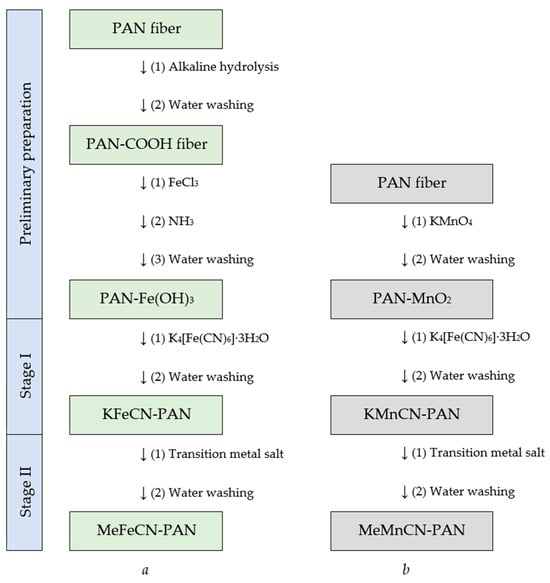
Figure 1.
Schemes for the production of fibrous ferrocyanide sorbents: (a) based on fiber prepared by precipitation of iron(III) hydroxide with ammonia; (b) based on fiber treated with potassium permanganate.
To obtain sorbents at the first stage, the pre-prepared PAN fiber was kept in a weakly acidic solution of potassium ferrocyanide under various conditions (concentration of potassium ferrocyanide, pH of the potassium ferrocyanide solution, temperature). After this, the fiber was washed with distilled water until a clear washing solution was achieved and dried at room temperature or in a stream of warm air.
Then, at the second stage, the fiber was kept in a solution of a transition metal salt (iron, cobalt, nickel, copper, or zinc) under various conditions (transition metal salt concentration, temperature). The produced sorbent was washed with distilled water till the clear washing solution and also dried at room temperature or in a stream of warm air.
Summary data on the synthesis of sorbents using various materials and synthesis conditions are given in Table 1.

Table 1.
Summary data on the synthesis of sorbents.
2.4. Analysis of the Obtained Sorbents by Structural Methods
IR spectra of the produced sorbents were recorded on a Spectrum 1000 spectrometer (Perkin Elmer, Waltham, MA, USA) using KBr tablets.
Thermogravimetric analysis of materials was carried out using a differential thermal analyzer DTG-60H (Shimadzu, Kyoto, Japan). The analysis was carried out in an argon atmosphere, with a heating rate of 10 °C/min.
Images of the structure of the materials under study were obtained by scanning electron microscopy using a Carl Zeiss CrossBeam, the XB 1540 device (Zeiss Int., Oberkochen, Germany), with an attachment for energy dispersive analysis.
2.5. Sorption of Cesium Ions
The sorption of cesium ions was carried out according to the method presented in [25]. A sample of the sorbent weighing 0.1 g, weighed with an accuracy of 0.0001 g, was continuously mixed with 20 mL of the test solution for 48 h. After that, the sorbent and solution were separated by filtration through a “white tape” filter paper, and the concentration of cesium in the filtrate was determined. Each experiment was repeated at least three times.
As a liquid phase, solutions of sodium nitrate with a concentration of 0.1 and 1 mol/L, pH 6, and in seawater of the composition given in Section 2.1 with a cesium concentration of 10–20 mg/L, were used. According to [24], these sodium nitrate solutions are recommended for assessing the sorption properties of sorbents concerning cesium.
Quantitative determination of cesium concentration in solutions was carried out on a KVANT-2 atomic adsorption spectrophotometer (Kortek LLC, Moscow, Russia) in the emission mode in an acetylene air flame at a wavelength of 852.1 nm. The error in determining cesium averaged 1% and did not exceed 2%.
The cesium distribution coefficient was determined by equation [9,47]
where C0 is the concentration of cesium in the initial solution, mg/L; C—cesium concentration in the filtrate, mg/L; V—volume of solution, mL; m—sorbent mass, g.
2.6. Sorption of Trace Amounts of 137Cs
Experiments on the sorption of 137Cs microquantities were carried out under static conditions by continuously mixing a sample of air-dry sorbent weighing about 0.05 g, weighed with an accuracy of 0.0001 g with 20 mL of solution for 24 h.
Then, the mixture was filtered through a “white tape” paper filter and the specific activity of 137Cs in the filtrate was determined by the direct radiometric method using the SKS-50M spectrometric complex (Green Star Technologies, Moscow, Russia). Based on analysis results, the distribution coefficient values of the corresponding radionuclide were calculated using equation [24,48]
where A0 and A are, respectively, the specific activity of the 137Cs radionuclide in the initial solution and the filtrate, Bq/L.
The solutions studied were 0.1 and 1 mol/L solutions of sodium nitrate with pH 6 and seawater of the above composition.
Before the start of the experiments, indicator amounts of 137Cs radionuclide in an amount of about 105 Bq/L were added to the solution and kept for 3 days at room temperature to achieve equilibrium of the various ionic and radioactive forms of solution components.
3. Results and Discussion
3.1. Selection of Optimal Materials and Conditions for Sorbent Synthesis
To obtain sorbents with the best cesium sorption performance, it was necessary to select the components and conditions for the synthesis of these sorbents, namely the concentration of potassium ferrocyanide, the pH of the potassium ferrocyanide solution, the transition metal salt and its concentration, and the synthesis temperature.
3.1.1. Assessment of the Effect of Potassium Ferrocyanide Concentration and pH
When obtaining sorbents, the prepared support was treated at the first stage with a solution of potassium ferrocyanide with different concentrations and at different pH levels. Two types of sorbents were obtained:
- KFeFC-PAN—sorbents based on potassium ferrocyanide and fiber prepared by precipitation of iron(III) hydroxide with ammonia (PAN-Fe(OH)3);
- KMnFC-PAN—sorbents based on potassium ferrocyanide and fiber treated with potassium permanganate (PAN-MnO2).
Figure 2 shows the dependences of the cesium distribution coefficients on the concentration of potassium ferrocyanide in a solution with pH 1, used in the preparation of sorbents.
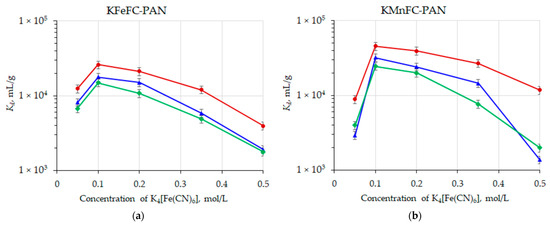
Figure 2.
Dependences of the cesium distribution coefficients upon sorption from 0.1 (●) and 1 (♦) mol/L solutions of sodium nitrate with pH 6 and seawater (▲) on the concentration of potassium ferrocyanide solution used at the first stage in sorbent preparation: (a) KFeFC-PAN; (b) KMnFC-PAN.
From the data obtained, it is seen that in both cases the optimal concentration of potassium ferrocyanide solution is 0.1–0.2 mol/L, which generally corresponds to data from other studies on the production of sorbents based on ferrocyanide [26,49].
Thus, according to [26], at high content of potassium ferrocyanide in the initial modifying solution, an unstable solid phase of variable composition is formed (KFe[Fe(CN)6]·nK[Fe(CN)6], where n is a variable value depending on the concentration of Kn[Fe(CN)6] in the initial solution), which, unlike normal and mixed iron(III) ferrocyanides, is soluble in water. Therefore, in cases of its formation, a certain fraction of iron(III) ferrocyanide passes from the solid phase into solution, which is the reason for the decrease in the sorption capacity of ferrocyanide ions during the modification process.
Figure 3 shows the dependence of distribution coefficients of cesium on the pH of a potassium ferrocyanide solution with a concentration of 0.1 mol/L used in the preparation of sorbents.
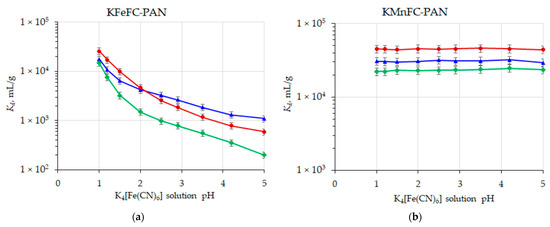
Figure 3.
Dependences of the cesium distribution coefficients upon sorption from 0.1 (●) and 1 (♦) mol/L solutions of sodium nitrate with pH 6 and seawater (▲) on the pH of potassium ferrocyanide solution used at the first stage in sorbent preparation: (a) KFeFC-PAN; (b) KMnFC-PAN.
For sorbents obtained based on PAN fiber prepared by precipitation of iron(III) hydroxide with ammonia (PAN-Fe(OH)3) [45], it was found that the best cesium distribution coefficients are achieved when using a ferrocyanide solution with pH of 1–1.5.
This is explained by the fact that at this pH, iron(III) hydroxide dissociates according to the main type [50]. At high pH, the dehydroxylation of iron(III) hydroxide is insignificant, so the modification of the fiber is less active. The data acquired coincide with the conclusions reached when obtaining the Anfezh sorbent [26]. The production of sorbents at a pH of less than 1 was not carried out, because according to [26], under these conditions, peptization of the sorbent occurs, accompanied by the transition of part of the ferrocyanide component into a solution.
In the case of using PAN fiber treated with potassium permanganate, the sorption characteristics of the resulting sorbents do not depend on the pH of the potassium ferrocyanide solution in the range from one to five, which is consistent with the data of other researchers [49].
3.1.2. Assessment of the Influence of Transition Metal Salt Type and Concentration
At the second stage of the synthesis, solutions of cobalt(II), nickel(II), zinc(II), copper(II), and iron(III) chlorides with a concentration of 0.01–0.1 mol/L were used for subsequent processing of sorbents. Pre-treatment of the prepared PAN-Fe(OH)3 and the PAN-MnO2 fiber (first stage of synthesis) was carried out with a 0.1 mol/L solution of K4Fe(CN)6 with pH 1.
Results obtained for sorbents based on KFeFC-PAN (PAN fiber prepared by precipitation of iron(III) hydroxide with ammonia PAN-Fe(OH)3, followed by treatment with potassium ferrocyanide) and KMnFC-PAN (PAN fiber treated with potassium permanganate PAN-MnO2, followed by treatment with potassium ferrocyanide) are shown in Figure 4 and Figure 5, respectively. More detailed dependences of the cesium distribution coefficients on the concentration of the transition metal salt, taking into account the concentration of potassium ferrocyanide used in the preparation of sorbents, are given in Supplementary Materials in Figures S1 and S2.
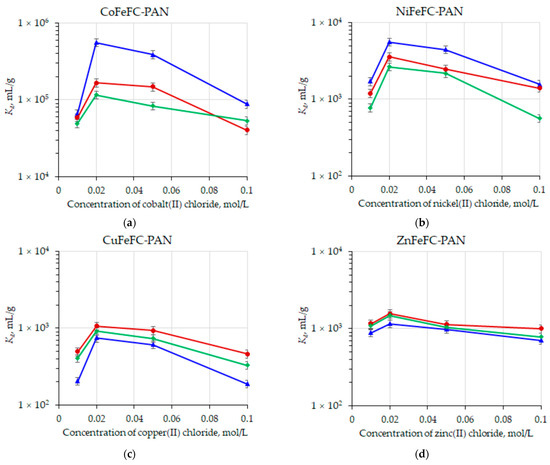
Figure 4.
Dependence of the cesium distribution coefficients upon sorption from 0.1 (●) and 1 (♦) mol/L solutions of sodium nitrate with pH 6 and seawater (▲) on the concentration of the transition metal salt used in sorbent preparation: (a) CoFeFC-PAN, (b) NiFeFC-PAN, (c) CuFeFC-PAN, (d) ZnFeFC-PAN.
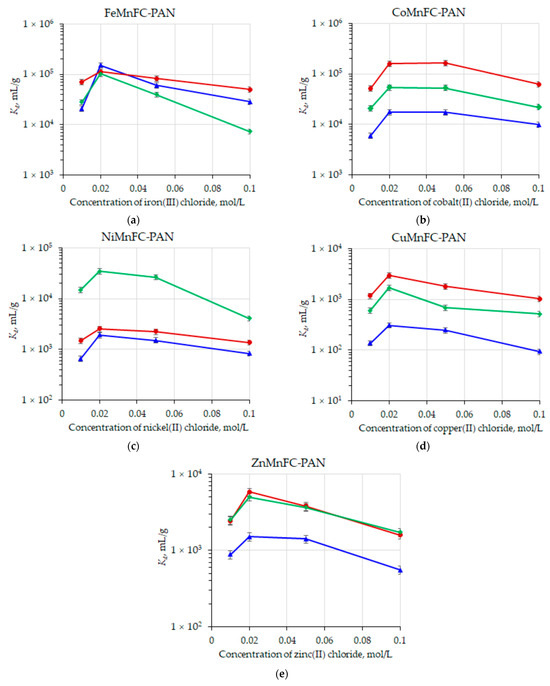
Figure 5.
Dependence of the cesium distribution coefficients upon sorption from 0.1 (●) and 1 (♦) mol/L solutions of sodium nitrate with pH 6 and seawater (▲) on the concentration of the transition metal salt used in sorbent preparation: (a) FeMnFC-PAN, (b) CoMnFC-PAN, (c) NiMnFC-PAN, (d) CuMnFC-PAN, (e) ZnMnFC-PAN.
It was found that for sorbents based on PAN fiber prepared by precipitation of iron(III) hydroxide with ammonia (PAN-Fe(OH)3), the best cesium distribution coefficients are achieved when cobalt(II) chloride is used for modification with a concentration of 0.02 mol/L—CoFeFC-PAN sorbent.
For sorbents based on fiber treated with potassium permanganate (PAN-MnO2), the best cesium distribution coefficients are achieved at a concentration of cobalt(II) chloride of 0.02–0.05 mol/L and iron(III) chloride of 0.02 mol/L—sorbents CoMnFC-PAN and FeMnFC-PAN, respectively.
In general, the degree of influence of the transition metals used on the cesium sorption can be expressed as follows:
- for sorbents based on PAN-Fe(OH)3 support:
Co2+ > Ni2+ > Zn2+ > Cu2+;
- for sorbents based on PAN-MnO2 support:
Fe3+ > Co2+ > Ni2+ > Zn2+ > Cu2+.
The analysis of work [38] devoted to the study of sorbents based on transition metal ferrocyanides shows that sorption characteristics largely depend on the type of transition metal in the inorganic phase. At the same time, various authors [13,38] obtained different series of decreases in the capacity of ferrocyanide sorbents concerning cesium. The authors associate such discrepancies with the peculiarities of the formation and binding of the matrix surface with the sorption-active phase, the properties of which depend on the method of composite sorbent obtaining [37,38].
3.1.3. Assessment of Synthesis Temperature Influence
The effect of synthesis temperature was assessed at the first and second stages of sorbent production—modification with potassium ferrocyanide and modification with a transition metal salt. The synthesis was carried out at room temperature (22–25 °C), as well as at 50 and 80 °C using an IR-1M3 rotary evaporator (LOIP, St. Petersburg, Russia).
The effect of reaction mixture temperature on the sorption-active properties of the materials produced was assessed in different variations, in particular under the influence of temperature only at the first stage, only at the second stage, and also at both stages.
It was found that synthesis temperature does not affect the sorption properties of the materials produced; the obtained cesium distribution coefficients differ within the error. The results obtained are shown in Supplementary Materials in Table S1.
Further studies were carried out on sorbents that showed the best sorption characteristics—CoFeFC-PAN, CoMnFC-PAN, and FeMnFC-PAN.
3.2. Structure of the Obtained Sorbents
The obtained sorbents were studied by structural methods using infrared (IR) spectrometry, thermogravimetric (TGA) analysis, and scanning electron microscopy (SEM) with energy dispersive analysis (EDS).
In the IR spectra of the obtained sorbents (Figure 6), peaks in the range of 2000–2150 cm–1 are visible, corresponding to the C≡N group coordinated with the metal, which indicates the presence of a complex ion [Fe(CN)6]4− [51].

Figure 6.
IR spectra of sorbents: (a) CoFeFC-PAN; (b) CoMnFC-PAN; (c) FeMnFC-PAN.
In the region of 3200–3500 cm–1, there is a wide absorption of the carboxyl group as well as of hydroxyl groups [52]. The absorption peak at 1730 cm–1 can be associated with stretching vibrations of the carbonyl group [53], which in turn is formed due to partial oxidation of the polymer chain during the fiber modification process.
The absorption bands in the region of 2940 cm–1 and 1450 cm–1 belong to the methyl and methylene groups of the polymer chain [53]; their positions are identical in the IR spectra.
Figure 7 shows the thermograms of obtained fibrous sorbents that have the following features. Heating to 300 °C was accompanied by a slight weight loss up to 6% for the CoFeFC-PAN sorbent (based on fiber prepared by precipitation of iron(III) hydroxide with ammonia) and up to 15% for FeMnFC-PAN and CoMnFC-PAN sorbents (based on fiber treated potassium permanganate); up to 200 °C, the heating corresponded to the process of dehydration of crystallization in molecular water [54]. When heated to 300 °C, two parallel processes probably occurred: the beginning of the cyclization of PAN, as well as the removal of crystallization and molecular water [54]. Also, at the stage from 290 to 450 °C for all samples, an increase in the rate of weight loss was observed, which is characterized by thermal-oxidative destruction of mixed transition metal ferrocyanides, with a maximum rate at 350 °C and 390 °C. At this stage, the complex ion [Fe(CN)6]4− decomposed with the formation of ferrites and transition metal oxides with the release of presumably cyanogen [55].
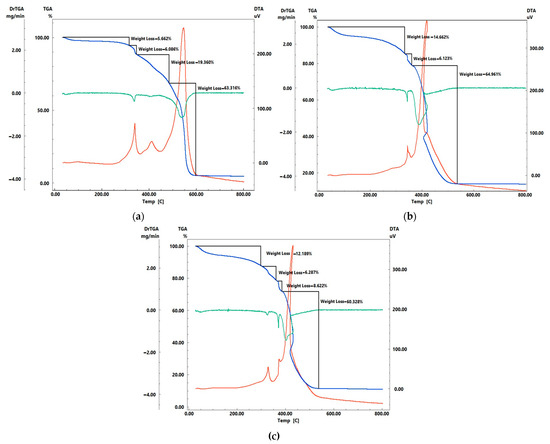
Figure 7.
Thermograms of the obtained sorbents: (a) CoFeFC-PAN; (b) CoMnFC-PAN; (c) FeMnFC-PAN (heating rate—5 °C/min; lines: blue—mass change curve; red—DTA curve; green—derivative of the DTA curve; black—areas of significant drop in mass in a certain temperature range, a description of which is given below).
At temperatures above 400 °C, there was a sharp decrease in the mass of the sample and an increase in the calorific value of the product as the temperature rose, which is associated with further carbonization and burnout of the organic residue [56]. With further heating to 800 °C, the weight curve gradually reached a plateau.
The SEM image of fibrous sorbents (Figure 8) shows the presence of interlayer spaces in which the formation of coarse-grained deposits occurs during the modification of PAN fiber. In addition, the formation of deposits also occurs on the entire surface of individual fibers, which is confirmed by the results of EDS analysis (Figure 9).
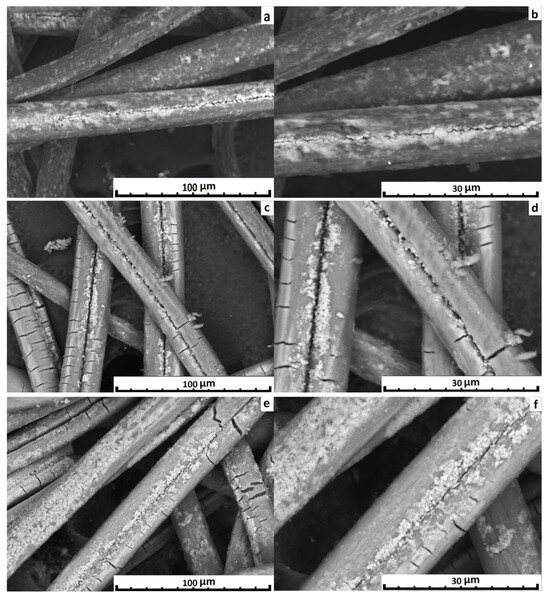
Figure 8.
SEM images: (a,b)—CoFeFC-PAN; (c,d)—CoMnFC-PAN; (e,f)—FeMnFC-PAN (100–30 µm).
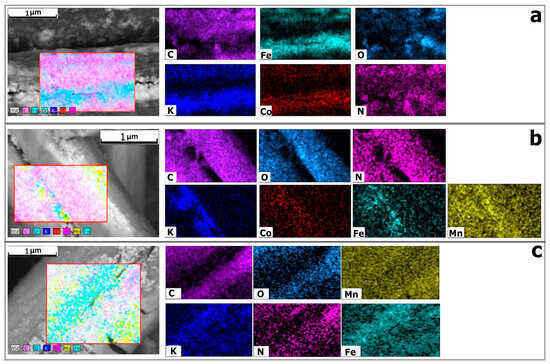
Figure 9.
EDS analysis: (a) CoFeFC-PAN; (b) CoMnFC-PAN; (c) FeMnFC-PAN.
Also, using energy dispersive analysis (Figure 9), the distribution of elements on the surface of composite materials was assessed, and the results obtained are presented in Table 2. It was found that during the formation of the ferrocyanide layer, the distribution of all components of the mixture occurs evenly, regardless of synthesis conditions.

Table 2.
Elemental composition of the surface of the resulting sorbents.
3.3. Sorption of Trace Amounts of 137Cs
To obtain comparative characteristics of the studied samples under similar conditions, 137Cs sorption was carried out on the following sorbents:
- FNS-10—sorbent based on nickel–potassium ferrocyanide deposited on silica gel (TU 2641-003-51255813-2007. Manufacturer: Institute of Physics and Chemistry of the Russian Academy of Sciences, Moscow, Russia);
- Termoksid-35—spherogranulated inorganic sorbent based on nickel ferrocyanide and zirconium hydroxide (TU 6200-305-12342266-98. Manufacturer: JSC “Inorganic Sorbents” (former NPF “Termoksid”), Zarechny, Russia).
The values of the obtained distribution coefficients of 137Cs on various sorbents during sorption from model solutions of the composition mentioned above are given in Table 3.

Table 3.
Elemental composition of the surface of obtained sorbents.
The results presented in Table 3 show that in all studied media, the CoFeFC-PAN sorbent has the highest sorption characteristics concerning 137Cs, that is, not inferior to the best industrial ferrocyanide sorbents.
In addition, it should be noted that previously, under similar conditions, when extracting from 0.1 and 1 mol/L solutions of sodium nitrate with pH 6 [19,24] and seawater [16], a large number of sorbents of various types were tested: organic ion exchange resins, natural and synthetic aluminosilicates and zeolites, oxyhydrates, phosphates, titanosilicates, ferrocyanide sorbents, carbon sorbents. Papers [16,19,24] present detailed comparative tables of 137Cs distribution coefficients. When comparing our results with those presented, it is seen that the effectiveness of obtained sorbents is not inferior to the effectiveness of existing materials. For example, the maximum determined distribution coefficients are (6.8 ± 0.6)∙104 mL/g and (6.1 ± 0.4)∙104 mL/g for ferrocyanide sorbents Anfezh and FD-M based on cellulose support. For the obtained sorbents, CoFeFC-PAN and FeMnFC-PAN, the distribution coefficients are greater than 105 mL/g, which indicates their promise for marine expeditionary research.
3.4. Selection of Optimal Conditions for Cesium Sorption
The study on the cesium sorption efficiency from solutions of various compositions (pH, concentration of Na+, K+, NH4+ ions) with the sorbents obtained in this work was also carried out.
The following results assessment of the effect of solution pH on cesium sorption were obtained, presented in Figure 10.
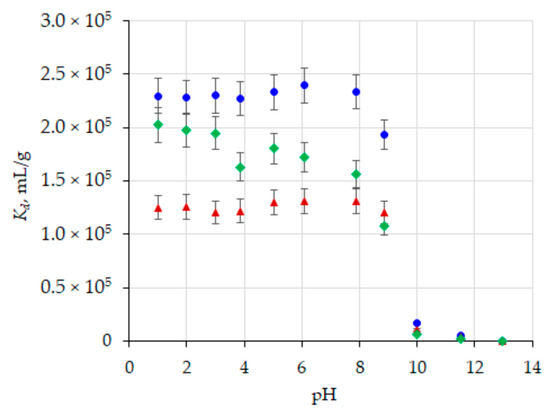
Figure 10.
Dependence of cesium distribution coefficients during sorption by produced sorbents CoFeFC-PAN (●), FeMnFC-PAN (▲), and CoMnFC-PAN (♦) on the pH of the test solution.
Based on the results of assessing the influence of solution pH, it is seen that the produced ferrocyanide sorbents are characterized by the independence of cesium distribution coefficients from pH in the range from one to eight, which is associated with the high selectivity of the ferrocyanide phase to cesium. At the same time, a decrease in the distribution coefficients of cesium in an alkaline medium at pH above nine was observed for sorbents, associated with peptization and partial destruction of the ferrocyanide phase. Overall, the results show that the sorbents obtained are potentially suitable for the sorption and concentration of cesium from liquid media in the pH range from one to nine.
Figure 11 shows the results of assessing the dependence of the cesium sorption efficiency on the type and concentration of the cation, which can have a significant competing effect.
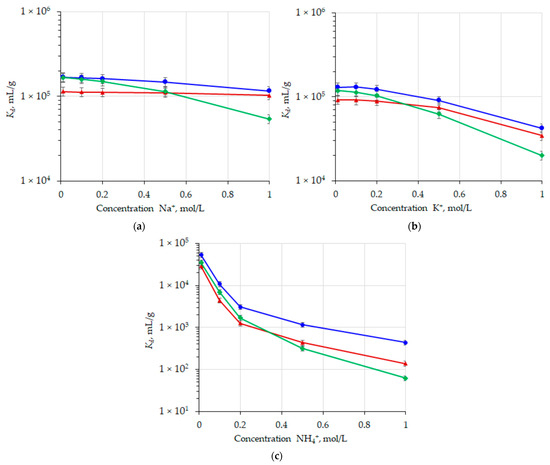
Figure 11.
Dependence of the cesium distribution coefficients during sorption by produced sorbents CoFeFC-PAN (●), FeMnFC-PAN (▲), and CoMnFC-PAN (♦) on the presence of cations in the test solution: (a) sodium; (b) potassium; (c) ammonium.
It is seen that the results obtained are in good agreement with the literature data on the sorption of alkali metal and ammonium ions by transition metal ferrocyanides [57]. A decrease in the values of cesium distribution coefficients is expressed in the series of cations present: Na+ > K+ > NH4+. Ferrocyanides sorb alkali metal ions due to the zeolite effect, which is more pronounced the closer the diameter of the sorbed ion is to the cross-sectional dimensions of the channels in the ferrocyanide structure. The maximum zeolite effect is observed for the Cs+ cation; the NH4+ ion is closest in size to the Cs+ ion. Thus, the effective diameter of the hydrated Cs+ cation is 0.25 nm; for comparison, the diameter of the NH4+ ion is also 0.25 nm, K+—0.3 nm, Na+—0.4–0.45 nm; therefore, the NH4+ ion has a greater effect on Cs+ sorption than the cations of other elements under consideration [58].
4. Conclusions
During our work, sorbents based on PAN fiber and transition metal ferrocyanides were synthesized for 137Cs sorption from natural and technological environments. It was shown that the best sorption characteristics were obtained at a concentration of potassium ferrocyanide solution of 0.1–0.2 mol/L and pH—1 for sorbents based on PAN fiber prepared by precipitation of iron(III) hydroxide with ammonia (PAN-Fe (OH)3), and pH 1–5 for sorbents based on PAN fiber treated with potassium permanganate (PAN-MnO2).
For sorbents based on PAN-Fe(OH)3 fiber, the best cesium distribution coefficients were achieved when cobalt(II) chloride with a concentration of 0.02 mol/L was used for modification (CoFeFC-PAN sorbent); for sorbents based on PAN-MnO2 fiber, the best cesium distribution coefficients were achieved when cobalt(II) chloride with a concentration of 0.02–0.05 mol/L (CoMnFC-PAN sorbent) and iron(III) chloride with a concentration of 0.02 mol/L (FeMnFC-PAN sorbent) were used for modification PAN. The independence of the properties of obtained sorbents from the temperature regime in the range of 25–80 °C is shown.
The studied structure of the obtained materials using infrared spectroscopy, thermogravimetric analysis, and scanning electron microscopy with energy dispersive analysis showed that during the formation of the ferrocyanide layer, the distribution of all components of the mixture occurs uniformly, regardless of the synthesis conditions. In the IR spectra of the obtained sorbents, peaks in the range of 2000–2150 cm−1 correspond to the C≡N group coordinated to the metal, which indicates the presence of a complex ion [Fe(CN)6]4−.
When studying the influence of solution composition (pH, concentration of Na+, K+, NH4+ cations), it was shown that the synthesized sorbents could be used to recover and concentrate cesium from liquid media in the pH range from one to nine containing macro quantities of sodium, potassium and ammonium ions. The presence of the NH4+ cation has the greatest effect on the cesium sorption; the influence of Na+ is minimal.
The sorption of 137Cs microquantities by the obtained sorbents was studied, the effectiveness of the obtained sorbents was shown in comparison with known adsorbents of various brands, and the possibility of using the obtained sorbents for the recovery and concentration of 137Cs from seawater was demonstrated.
In the course of further research, a more detailed study of the physicochemical parameters of cesium sorption is planned using the obtained materials, namely sorption and desorption kinetics, isotherms, selectivity, and sorption dynamics in solutions of complex chemical composition. In addition, 137Cs sorption efficiency from large volumes (up to 250 L) of natural water will be assessed at different flow rates of the test solution. During the expedition, radioanalytical monitoring of 137Cs in surface seawater samples will be performed using the obtained sorbents.
Supplementary Materials
The following supporting information can be downloaded at: https://www.mdpi.com/article/10.3390/app14020627/s1, Figure S1: Dependence of cesium distribution coefficients upon sorption from 0.1 (a,d,g,j) and 1 mol/L (b,e,h,k) solutions of sodium nitrate with pH 6 and seawater (c,f,i,l) on the concentration of potassium ferrocyanide (0.05 (▲), 0.1 (●), 0.2 (♦), 0.5(■)) and the concentration of the transition metal salt used in the preparation of sorbents: (a–c)—CoFeFC-PAN, (d–f)—NiFeFC-PAN, (g–i)—CuFeFC-PAN, (j–l)—ZnFeFC-PAN; Figure S2: Dependence of cesium distribution coefficients upon sorption from 0.1 (a,d,g,j,m) and 1 mol/L (b,e,h,k,n) solutions of sodium nitrate with pH 6 and seawater (c,f,i,l,o) on the concentration of potassium ferrocyanide (0.05 (▲), 0.1 (●), 0.2 (♦), 0.5(■)) and the concentration of the transition metal salt used in the preparation of sorbents: (a–c)—FeMnFC-PAN, (d–f)—CoMnFC-PAN, (g–i)—NiMnFC-PAN, (j–l)—CuMnFC-PAN, (m–o)—ZnMnFC-PAN; Table S1: Cesium distribution coefficients during sorption from a 0.1 mol/L sodium nitrate solution with pH 6 and seawater depending on synthesis temperatures at the first and second stages of the synthesis of several sorbents.
Author Contributions
Conceptualization, N.A.B.; methodology, N.A.B., E.A.T., V.V.M. and I.G.T.; validation, N.A.B. and V.V.M.; formal analysis, I.G.S., V.A.R. and N.A.N.; investigation, I.G.S., V.A.R., N.A.B., N.A.N. and V.S.Y.; resources, N.A.B., V.V.M. and V.S.Y.; data curation, I.G.S., V.A.R., N.A.N., E.A.T. and V.S.Y.; writing—original draft preparation, I.G.S., N.A.B., E.A.T., V.V.M. and I.G.T.; writing—review and editing, all authors; visualization, I.G.S., V.A.R., N.A.B. and E.A.T.; supervision, N.A.B. and I.G.T.; project administration, N.A.B.; funding acquisition, N.A.B. All authors have read and agreed to the published version of the manuscript.
Funding
The research was carried out with the financial support of Sevastopol State University, project No. 42-01-09/253/2023-2.
Institutional Review Board Statement
Not applicable.
Informed Consent Statement
Not applicable.
Data Availability Statement
The raw data supporting the conclusions of this article will be made available by the authors on request.
Conflicts of Interest
The authors declare no conflicts of interest.
References
- Buesseler, K.; Aoyama, M.; Fukasawa, M. Impacts of the Fukushima nuclear power plants on marine radioactivity. Environ. Sci. Technol. 2011, 45, 9931–9935. [Google Scholar] [CrossRef]
- Novikov, A.P. Migration and concentration of artificial radionuclides in environmental objects. Geochem. Int. 2010, 48, 1263–1387. [Google Scholar] [CrossRef]
- Kondev, F.G.; Wang, M.; Huang, W.J.; Naimi, S.; Audi, G. The NUBASE2020 evaluation of nuclear physics properties. Chin. Phys. C 2021, 45, 030001. [Google Scholar] [CrossRef]
- Hirose, K.; Aoyama, M.; Igarashi, Y.; Komura, K. Improvement of 137Cs analysis in small volume seawater samples using the Ogoya underground facility. J. Radioanal. Nucl. Chem. 2008, 276, 795–798. [Google Scholar] [CrossRef]
- Egorin, A.; Palamarchuk, M.; Tokar, E.; Tutov, M.; Marinin, D.; Avramenko, V. Concentrating cesium-137 from seawater using resorcinol-formaldehyde resin for radioecological monitoring. Radiochim. Acta 2017, 105, 121–127. [Google Scholar] [CrossRef]
- Egorin, A.M.; Sokolnitskaya, T.A.; Matveikin, M.Y.; Avramenko, V.A.; Tutov, M.V.; Tokar’, E.A. Composite selective sorbents for sea water decontamination from cesium and strontium radionuclides. Doklady Phys. Chem. 2015, 460, 10–14. [Google Scholar] [CrossRef]
- Zhuravlev, I. Titanium Silicates Precipitated on the Rice Husk Biochar as Adsorbents for the Extraction of Cesium and Strontium Radioisotope Ions. Colloids Interfaces 2019, 3, 36. [Google Scholar] [CrossRef]
- Ivanov, N.P.; Marmaza, P.A.; Shichalin, O.O.; Drankov, A.N.; Kaspruk, G.D.; Pisarev, S.M.; Fedorets, A.N. Extraction of Cs(I) and Sr(II) From liquid media using crystalline titanosilicates obtained by hydrothermal synthesis. Radiat. Saf. Issues 2023, 2, 14–19. (In Russian) [Google Scholar]
- Yang, J.; Wang, M.; Zhang, L.; Lu, Y.; Di, B.; Shi, K.; Hou, X. Investigation on the thermal stability of cesium in soil pretreatment and its separation using AMP-PAN resin. J. Radioanal. Nucl. Chem. 2023, 332, 877–885. [Google Scholar] [CrossRef]
- Lin, M.; Kajan, I.; Schumann, D.; Türler, A.; Fankhauser, A. Selective Cs-removal from highly acidic spent nuclear fuel solutions. Radiochim. Acta 2020, 108, 615–626. [Google Scholar] [CrossRef]
- Breier, C.F.; Pike, S.M.; Sebesta, F.; Tradd, K.; Breier, J.A.; Buesseler, K.O. New applications of KNiFC-PAN resin for broad scale monitoring of radiocesium following the Fukushima Dai-ichi nuclear distaster. J. Radioanal. Nucl. Chem. 2016, 307, 2193–2200. [Google Scholar] [CrossRef]
- Nilchi, A.; Malek, B.; Maragheh, M.G.; Khanchi, A. Exchange properties of cyanide complex. Part I. Ion exchange of cesium on ferrocyanides. J. Radioanal. Nucl. Chem. 2003, 258, 457–462. [Google Scholar] [CrossRef]
- Kumamoto, Y.; Aoyama, M.; Hamajima, Y.; Murata, A. Activity concentration of Fukushima-derived radiocesium in the western subarctic area of the North Pacific Ocean in summer 2017. J. Radioanal. Nucl. Chem. 2020, 325, 263–270. [Google Scholar] [CrossRef]
- Hegedűs, M.; Tazoe, H.; Yang, G.; Tamakuma, Y.; Hosoda, M.; Akata, N.; Tokonami, S. Caesium retention characteristics of KNIFC–PAN resin from river water. Radiat. Prot. Dosim. 2020, 190, 320–323. [Google Scholar] [CrossRef]
- Zhang, J.; Li, Y.; Fu, Y.; Liao, H.; Li, B. Preparation of SiO2-KMCHCF composites and its adsorption characteristics for Cs+ and Sb(V) ions. J. Radioanal. Nucl. Chem. 2022, 331, 4211–4226. [Google Scholar] [CrossRef]
- Bezhin, N.A.; Dovhyi, I.I.; Milyutin, V.V.; Kaptakov, V.O.; Kozlitin, E.A.; Egorin, A.M.; Tokar’, E.A.; Tananaev, I.G. Study of sorbents for analysis of radiocesium in seawater samples by one-column method. J. Radioanal. Nucl. Chem. 2021, 327, 1095–1103. [Google Scholar] [CrossRef]
- Sangvanich, T.; Sukwarotwat, V.; Wiacek, R.J.; Grudzien, R.M.; Fryxell, G.E.; Addleman, R.S.; Timchalk, C.; Yantasee, W. Selective capture of cesium and thallium from natural waters and simulated wastes with copper ferrocyanide functionalized mesoporous silica. J. Hazard. Mater. 2010, 182, 225–231. [Google Scholar] [CrossRef]
- Matel, L.; Dulanska, S.; Silikova, V. Composite sorbents for radionuclide separation. In XXXIX Days of Radiation Protection. Proceedings of Presentations and Posters; Slovenska Zdravotnicka Univerzita: Bratislava, Slovakia, 2018; p. 578. [Google Scholar]
- Milyutin, V.V.; Nekrasova, N.A.; Kaptakov, V.O. Modern Sorption Materials for Cesium and Strontium Radionuclide Extraction from Liquid Radioactive Waste. Radioact. Waste 2020, 4, 66–73. [Google Scholar] [CrossRef]
- Veleshko, A.N.; Veleshko, I.E.; Rumyantseva, E.V.; Dmitrieva, N.A. Chitosan is a promising material for the isolation and concentration of radionuclides from natural and man-made environments. Ecol. Sys. Devices 2013, 11, 8–15. (In Russian) [Google Scholar]
- Kosyakov, V.N.; Veleshko, A.N.; Veleshko, I.E. Determination of 137Cs in seawater under the field conditions. Radiochemistry 2006, 48, 589–592. [Google Scholar] [CrossRef]
- Tokar’, E.; Zemskova, L.; Tutov, M.; Tananaev, I.; Dovhyi, I.; Egorin, A. Development and practical evaluation of the scheme for 137Cs concentrating from seawater using chitosan and mixed ferrocyanides of Zn-K and Ni-K. J. Radioanal. Nucl. Chem. 2020, 325, 567–575. [Google Scholar] [CrossRef]
- Voronina, A.V.; Noskova, A.Y.; Semenishchev, V.S.; Gupta, D.K. Decontamination of seawater from 137Cs and 90Sr radionuclides using inorganic sorbents. J. Environ. Radioact. 2020, 217, 106210. [Google Scholar] [CrossRef]
- Nekrasova, N.A.; Milyutin, V.V.; Kaptakov, V.O.; Kozlitin, E.A. Inorganic Sorbents for Wastewater Treatment from Radioactive Contaminants. Inorganics 2023, 11, 126. [Google Scholar] [CrossRef]
- Kiener, J.; Limousy, L.; Jeguirim, M.; Le Meins, J.-M.; Hajjar-Garreau, S.; Bigoin, G.; Ghimbeu, C.M. Activated Carbon/Transition Metal (Ni, In, Cu) Hexacyanoferrate Nanocomposites for Cesium Adsorption. Materials 2019, 12, 1253. [Google Scholar] [CrossRef]
- Remez, V.P.; Zelenin, V.I.; Smirnov, A.L.; Raspopin, S.P.; Matern, A.I.; Morzherin, Y.Y. Cellulose-inorganic sorbents in radiochemical analysis II. Synthesis and properties of ANFEZH® sorbent. Sorpt. Chromatogr. Process. 2009, 9, 739–744. (In Russian) [Google Scholar]
- Gulin, S.B.; Mirzoyeva, N.Y.; Egorov, V.N.; Polikarpov, G.G.; Sidorov, I.G.; Proskurnin, V.Y. Secondary radioactive contamination of the Black Sea after Chernobyl accident: Recent levels, pathways and trends. J. Environ. Radioact. 2013, 124, 50–56. [Google Scholar] [CrossRef]
- Gulin, S.B.; Egorov, V.N.; Duka, M.S.; Sidorov, I.G.; Proskurnin, V.Y.; Mirzoyeva, N.Y.; Bey, O.N.; Gulina, L.V. Deep-water profiling of 137Cs and 90Sr in the Black Sea: A further insight into dynamics of the post-Chernobyl radioactive contamination. J. Radioanal. Nucl. Chem. 2015, 304, 779–783. [Google Scholar] [CrossRef]
- Sergienko, V.I.; Avramenko, V.A.; Zheleznov, V.V.; Mayorov, V.Y. Method for Producing Ferrocyanide Sorbents. Patent No. 2345833 Russian Federation, IPC B01J 20/02, B01J 20/30, 10 February 2009. (In Russian). [Google Scholar]
- Ivanets, A.I.; Shashkova, I.L.; Drozdova, N.V.; Davydov, D.Y.; Radkevich, A.V. Recovery of cesium ions from aqueous solutions with composite sorbents based on tripolite and copper(II) and nickel(II) ferrocyanides. Radiochemistry 2014, 56, 524–528. [Google Scholar] [CrossRef]
- Voronina, A.V.; Nogovitsyna, E.V.; Semenishchev, V.S.; Blinova, M.O. Method for Producing Inorganic Ferrocyanide Sorbent. Patent No. 2746194 Russian Federation, IPC B01J 20/02, B01J 20/32, 8 April 2021. (In Russian). [Google Scholar]
- Voronina, A.V.; Noskova, A.Y.; Semenishchev, V.S.; Blinova, M.O.; Nikiforov, A.F. Purification of sea water from cesium and strontium radionuclides. Water Manag. Russia Probl. Technol. Manag. 2019, 6, 102–120. (In Russian) [Google Scholar]
- Le, Q.T.N.; Cho, K. Caesium adsorption on a zeolitic imidazolate framework (ZIF-8) functionalized by ferrocyanide. J. Colloid Interface Sci. 2021, 581, 741–750. [Google Scholar] [CrossRef]
- Delchet, C.; Delchet, C.; Tokarev, A.; Dumail, X.; Toquer, G.; Barre’, Y.; Guari, Y.; Guerin, C.; Larionova, J.; Grandjean, A. Extraction of radioactive cesium using innovative functionalized porous materials. RSC Adv. 2012, 2, 5707–5716. [Google Scholar] [CrossRef]
- Shahzad, A.; Moztahida, M.; Tahir, K.; Kim, B.; Jeon, H.; Ghani, A.A.; Maile, N.; Jang, J.; Lee, D.S. Highly effective prussian blue-coated MXene aerogel spheres for selective removal of cesium ions. J. Nucl. Mater. 2020, 539, 152277. [Google Scholar] [CrossRef]
- Zhang, H.; Hodges, C.S.; Mishra, P.K.; Yoon, J.Y.; Hunter, T.N.; Lee, J.W.; Harbottle, D. Bio-Inspired Preparation of Clay–Hexacyanoferrate Composite Hydrogels as Super Adsorbents for Cs+. ACS Appl. Mater. Interfaces 2020, 12, 33173–33185. [Google Scholar] [CrossRef]
- Vincent, T.; Vincent, C.; Guibal, E. Immobilization of Metal Hexacyanoferrate Ion-Exchangers for the Synthesis of Metal Ion Sorbents—A Mini-Review. Molecules 2015, 20, 20582–20613. [Google Scholar] [CrossRef]
- Vincent, T.; Vincent, C.; Barré, Y.; Guari, Y.; Le Saout, G.; Guibal, E. Immobilization of metal hexacyanoferrates in chitin beads for cesium sorption: Synthesis and characterization. J. Mater. Chem. A 2014, 2, 10007–10021. [Google Scholar] [CrossRef]
- Goto, S.; Umino, S.; Amakai, W.; Fujiwara, K.; Sugo, T.; Kojima, T.; Kawai-Noma, S.; Umeno, D.; Saito, K. Impregnation structure of cobalt ferrocyanide microparticles by the polymer chain grafted onto nylon fiber. J. Nucl. Sci. Technol. 2016, 53, 1251–1255. [Google Scholar] [CrossRef]
- Watari, K.; Imai, K.; Izawa, M. Isolation of 137Cs with Copper Ferrocyanide-Anion Exchange Resin. J. Nucl. Sci. Technol. 1967, 4, 190–194. [Google Scholar] [CrossRef]
- Bokor, I.; Sdraulig, S.; Jenkinson, P.; Madamperuma, J.; Martin, P. Development and validation of an automated unit for the extraction of radiocaesium from seawater. J. Environ. Radioact. 2016, 151, 530–536. [Google Scholar] [CrossRef]
- Ohara, E.; Soejima, T.; Ito, S. Removal of low concentration Cs(I) from water using Prussian blue. Inorganica Chim. Acta 2021, 514, 120029. [Google Scholar] [CrossRef]
- Rustamov, M.K.; Gafurova, D.A.; Karimov, M.M.; Rustamova, N.M.; Bekchonov, D.Z.; Mukhamediev, M.G. Application of ion-exchange materials with high specific surface area for solving environmental problems. Russ. J. Gen. Chem. 2014, 84, 2545–2551. [Google Scholar] [CrossRef]
- Anfilatova, O.V. Register of Certified Reference Materials of the Substances and Materials Composition and Properties of the States Parties to the Agreement. Certif. Ref. Mater. 2009, 4, 70–84. (In Russian) [Google Scholar]
- Dovhyi, I.I.; Kremenchutskii, D.A.; Bezhin, N.A.; Shibetskaya, Y.G.; Tovarchii, Y.Y.; Egorin, A.M.; Tokar, E.A.; Tananaev, I.G. MnO2 fiber as a sorbent for radionuclides in oceanographic investigations. J. Radioanal. Nucl. Chem. 2020, 323, 539–547. [Google Scholar] [CrossRef]
- Bezhin, N.A.; Frolova, M.A.; Dovhyi, I.I.; Kozlovskaia, O.N.; Slizchenko, E.V.; Shibetskaia, I.G.; Khlystov, V.A.; Tokar’, E.A.; Tananaev, I.G. The Sorbents Based on Acrylic Fiber Impregnated by Iron Hydrox-ide (III): Production Methods, Properties, Application in Oceanographic Research. Water 2022, 14, 2303. [Google Scholar] [CrossRef]
- Al-Ghamdi, A.A.; Galhoum, A.A.; Alshahrie, A.; Al-Turki, Y.A.; Al-Amri, A.M.; Wageh, S. Mesoporous Magnetic Cysteine Functionalized Chitosan Nanocomposite for Selective Uranyl Ions Sorption: Experimental, Structural Characterization, and Mechanistic Studies. Polymers 2022, 14, 2568. [Google Scholar] [CrossRef]
- Maslova, M.; Mudruk, N.; Ivanets, A.; Shashkova, I.; Kitikova, N. A novel sorbent based on Ti-Ca-Mg phosphates: Synthesis, characterization, and sorption properties. Environ. Sci. Pollut. Res. 2020, 27, 3933–3949. [Google Scholar] [CrossRef] [PubMed]
- Merkushkin, A.O.; Medvedev, V.P.; Rezchikov, D.E. Method for Producing Thin-Layer Ferrocyanide Sorbents. Patent No. 2172208 Russian Federation, IPC B01J 20/02, B01J 20/30, 20 August 2001. (In Russian). [Google Scholar]
- Liu, X.; Millero, F.J. The solubility of iron hydroxide in sodium chloride solutions. Geochim. Cosmochim. Acta 1999, 63, 3487–3497. [Google Scholar] [CrossRef]
- Andriukonis, E.; Ramanaviciene, A.; Ramanavicius, A. Synthesis of Polypyrrole Induced by [Fe(CN)6]3– and Redox Cycling of [Fe(CN)6]4–/[Fe(CN)6]3–. Polymers 2018, 10, 749. [Google Scholar] [CrossRef] [PubMed]
- Ma, F.; Du, C.W.; Zhou, J.M.; Shen, Y.Z. Investigation of soil properties using different techniques of mid-infrared spectroscopy. Investigation of soil properties using different techniques of mid-infrared spectroscopy. Eur. J. Soil Sci. 2019, 70, 96–106. [Google Scholar] [CrossRef]
- Mohan, V.; Naske, C.D.; Britten, C.N.; Karimi, L.; Walters, K.B. Hydroxide-catalyzed cleavage of selective ester bonds in phosphatidylcholine: An FTIR study. Vib. Spectrosc. 2020, 109, 103055. [Google Scholar] [CrossRef]
- Martin, H.J.; Luo, H.; Chen, H.; Do-Thanh, C.-L.; Kearney, L.T.; Mayes, R.; Naskar, A.K.; Dai, S. Effect of the Ionic Liquid Structure on the Melt Processability of Polyacrylonitrile Fibers. ACS Appl. Mater. Interfaces 2020, 12, 8663–8673. [Google Scholar] [CrossRef]
- Hamoud, M.A.; Allan, K.F.; Sanad, W.A.; Saad, E.A.; Mahmoud, M.R. Synthesis of PAN/ferrocyanide composite incorporated with cetrimonium bromide and its employment as a bifunctional adsorbent for coremoval of Cs+ and HCrO4− from aqueous solutions. J. Radioanal. Nucl. Chem. 2020, 324, 647–661. [Google Scholar] [CrossRef]
- Jing, M.; Wang, C.; Wang, Q.; Bai, Y.-J.; Zhu, B. Chemical structure evolution and mechanism during pre-carbonization of PAN-based stabilized fiber in the temperature range of 350–600 °C. Polym. Degrad. Stab. 2007, 92, 1737–1742. [Google Scholar] [CrossRef]
- Voronina, A.V.; Semenishchev, V.S. Influence of the concentrations of potassium, sodium, and ammonium ions on the cesium sorption with mixed nickel potassium ferrocyanide sorbent based on hydrated titanium dioxide. Radiochemistry 2013, 55, 399–403. [Google Scholar] [CrossRef][Green Version]
- Brian, M. Tissue Basics of Analytical Chemistry and Chemical Equilibria: A Quantitative Approach; John Wiley & Sons: Hoboken, NJ, USA, 2023; 496p. [Google Scholar]
Disclaimer/Publisher’s Note: The statements, opinions and data contained in all publications are solely those of the individual author(s) and contributor(s) and not of MDPI and/or the editor(s). MDPI and/or the editor(s) disclaim responsibility for any injury to people or property resulting from any ideas, methods, instructions or products referred to in the content. |
© 2024 by the authors. Licensee MDPI, Basel, Switzerland. This article is an open access article distributed under the terms and conditions of the Creative Commons Attribution (CC BY) license (https://creativecommons.org/licenses/by/4.0/).